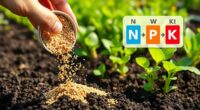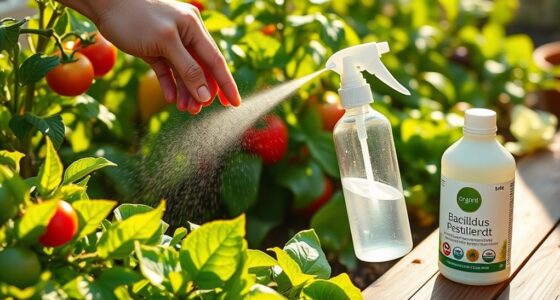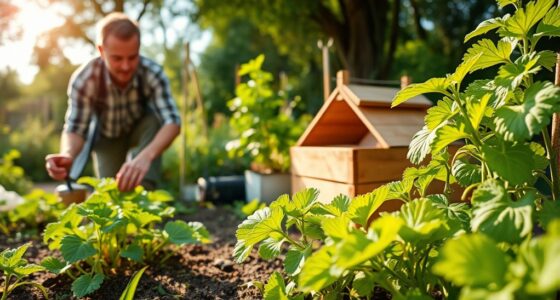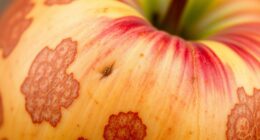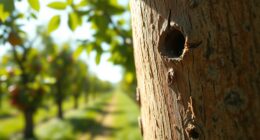To create a DIY soap spray, mix 1-2 teaspoons of mild liquid soap in a quart of water, avoiding harsh additives. Test the solution on a small plant area first to prevent damage, then spray directly on affected spots, especially undersides of leaves. Repeat every few days until pests decline, making sure to target pests like aphids or spider mites while protecting beneficial insects. Keep exploring for more tips on using soap sprays effectively.
Key Takeaways
- Mix 1-2 teaspoons of mild liquid soap per quart of water to create an effective, natural insecticidal spray.
- Properly identify pests like aphids or whiteflies to ensure targeted and effective treatment.
- Conduct a patch test before full application to prevent plant damage and monitor for adverse reactions.
- Spray directly on affected areas, especially undersides of leaves, and reapply every few days as needed.
- Use soap sprays as part of an integrated pest management plan to promote a healthy, sustainable garden ecosystem.
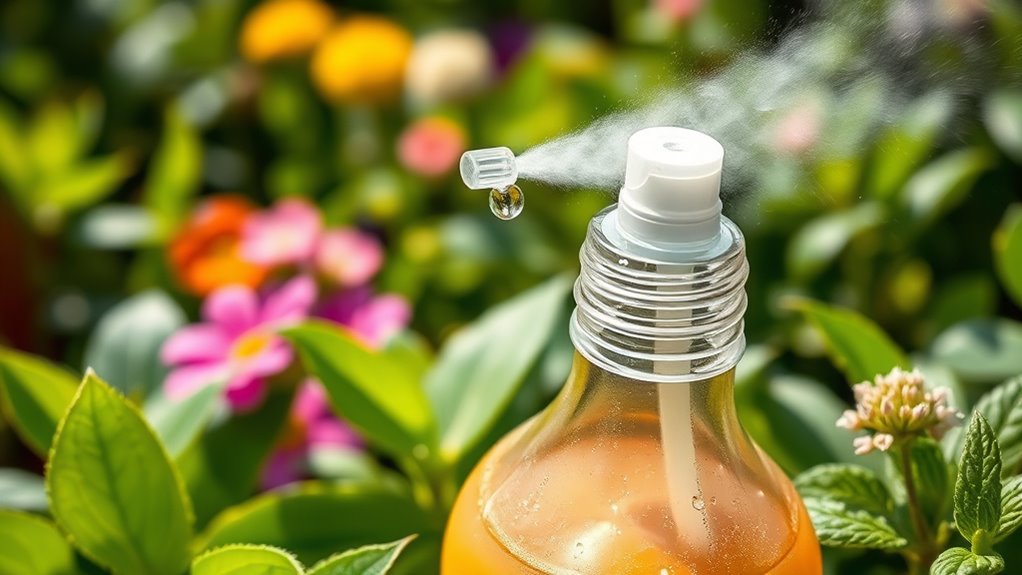
Wondering how to keep bugs away without harmful chemicals? Using soap sprays is a simple, effective way to protect your garden while supporting the health of beneficial insects. Unlike chemical pesticides, a DIY soap spray targets pests without harming pollinators like bees and ladybugs, which are essential for a healthy garden ecosystem. The key to success is pest identification—knowing which insects are damaging your plants helps you apply the right treatment and avoid accidentally harming helpful bugs. Once you’ve correctly identified the pests, you can create a targeted soap solution that suffices to control their populations.
Using soap sprays helps control pests naturally while protecting beneficial insects.
The most common pests that respond well to soap sprays include soft-bodied insects like aphids, spider mites, and whiteflies. These pests have thin exoskeletons, making them vulnerable to the soap solution. When you spot these insects on your plants, it’s time to act. Start by inspecting your plants closely—look for clusters of tiny insects or sticky residue on leaves, which are clear signs of infestation. Proper pest identification is vital because not all bugs need to be eradicated—some, like ladybugs and parasitic wasps, are beneficial insects that help keep pest populations in check naturally. If you’re unsure about which insects are pests, consult reliable gardening resources or local extension services. Clearing up confusion guarantees you don’t accidentally eliminate the beneficial insects that help your garden thrive.
Creating a soap spray is straightforward. Mix one to two teaspoons of mild liquid soap, such as castile soap or pure dish soap, into a quart of water. Avoid using harsh detergents or soaps with added fragrances or degreasers, as these can damage your plants. Before applying the solution broadly, do a patch test on a small section of your plant to check for any adverse reactions. If the leaves show signs of damage within 24 hours, dilute the mixture further or try a different soap. When applying, spray the solution directly onto affected areas, making sure to cover the undersides of leaves where pests often hide. Repeat this process every few days until you see a reduction in pests, but stop if plants show signs of stress. Additionally, understanding the importance of contrast ratio in projectors can help you create the perfect viewing environment for garden videos or educational content about pest management.
Using soap sprays effectively balances pest control with environmental health. It’s a sustainable way to keep your garden thriving while encouraging beneficial insects to do their natural job. Remember, proper pest identification not only prevents unnecessary harm but also guarantees your DIY approach is as effective as possible. With patience and attention, you’ll create a safer, healthier garden that resists pests without sacrificing the beneficial insects that support your garden’s ecosystem.
Frequently Asked Questions
How Often Should I Reapply Soap Sprays?
You should reapply soap sprays every 7 to 10 days, depending on the severity of the pest problem. Keep weather considerations in mind; if it rains, you’ll need to reapply sooner, as the soap spray can wash off. Also, inspect your plants regularly, and if pests reappear or the spray becomes less effective, increase the application frequency to protect your garden effectively.
Can Soap Sprays Harm Beneficial Insects?
You might wonder if soap spray impacts beneficial insects. Generally, soap sprays are safe for beneficial insect safety when used correctly, but over-application can harm pollinators and predatory insects. To minimize soap spray impact, target affected plants carefully, avoid spraying during peak insect activity, and apply in the early morning or late evening. Proper use helps protect beneficial insects while controlling pests effectively.
Which Plants Are Most Sensitive to Soap Sprays?
You should know that plant sensitivity varies based on soap concentration and species. Some plants, like azaleas, ferns, and succulents, are more sensitive and may get damaged even with low soap levels. To prevent harm, always test your soap spray on a small area first. Adjust the soap concentration carefully, using milder solutions for delicate plants, and monitor their response to avoid unintended damage.
How Do I Store Leftover Soap Spray Solution?
Ever wondered what happens to your leftover soap spray solution? Proper storage tips can extend its solution longevity and keep it effective. Store the mixture in an airtight container, away from direct sunlight and extreme temperatures. Label it clearly, and use it within a week for best results. Be cautious—storing it improperly might compromise its potency, so pay attention to these details to ensure your DIY insecticide remains ready when you need it.
Are There Any Homemade Alternatives to Soap Sprays?
You’re asking about homemade alternatives to soap sprays, which are great for natural pest control. You can make effective homemade insecticides using common ingredients like neem oil, garlic, chili peppers, or insecticidal soap. Mix these with water to create a safe, DIY solution for your garden. These natural pest control options are eco-friendly, affordable, and easy to customize, helping you keep pests at bay without harsh chemicals.
Conclusion
By trying this soap spray, you’re helping your garden thrive naturally. Imagine John, a gardener who struggled with pesky aphids until he switched to this simple solution—now his roses bloom beautifully, free of harmful chemicals. You can experience the same success and protect your plants safely. Just mix, spray, and enjoy a healthier garden. Give it a try today, and watch your garden flourish with less worry and more beauty.

